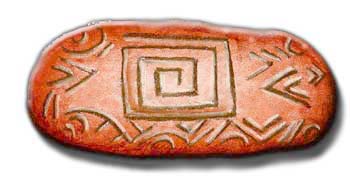

NORMALLY
A SIGN STANDS FOR A SINGLE WORD, WHEREAS THE GRAMMATICAL INDICATIONS WERE
OMITTED OR WERE SIMPLY UNDERSTOOD WITH THE HELP OF THE SURROUNDING CONTEXT;
IT PROBABLY SIGNIFIED THE STEM OF A WORD IN WRITING, WHILST OMITTING ITS
INFLEXIONAL ELEMENTS.

A
meander in the centre surrounded by an inscription studded with chevrons,
semicircles and parallel lines characterise this emblematic, oval terracotta
plaque. It was found in Banjica, near Belrade, and is 7200-7000 years
old.
Is it perhaps a sacred form of bread? asks Marija Gimbutas (1991).
Is it perhaps a sacred form of bread? asks Marija Gimbutas (1991).
The script of the Balkan-Danube agriculturalists could have had a system in many ways similar to the Sumerian, Chinese, Hindu and pre-Columbian ones. In particular, Gimbutas (1999) even considers it similar in structure to the Sumerian writing system, where the phrases are not always syntactically complete. Some seem to follow a set of rules, others, having lost a few of their elements on the way, are similar to a form of shorthand. Normally, a sign stood for one word and the grammatical indications were omitted or understood from the context or marked by small linear signs.